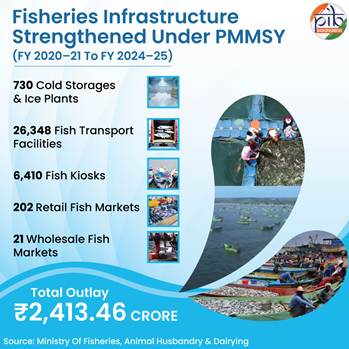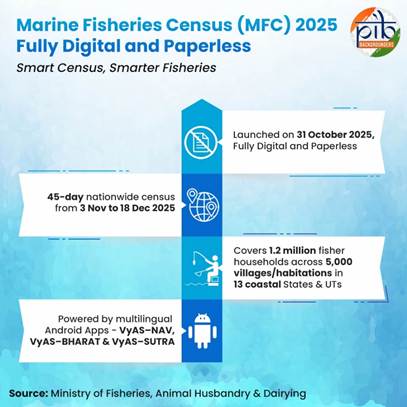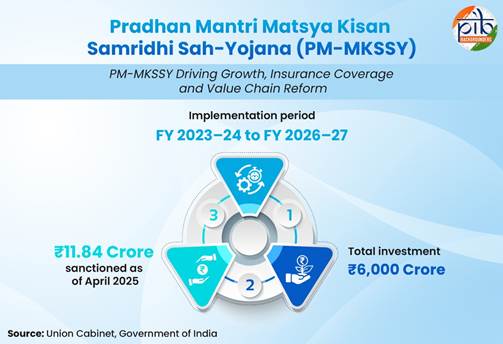PIB Headquarters
Strengthening Marine Resources and Livelihoods: India Celebrates World Fisheries Day 2025
Empowering Fishers and Advancing the Blue Economy
Posted On:
20 NOV 2025 4:30PM by PIB Delhi
Key Takeaways
- India celebrates World Fisheries Day 2025 highlighting sustainability, livelihoods, and blue economy growth.
- India is the second-largest fish-producing country and one of the largest shrimp producers in the World.
- India’s fish production has more than doubled from 96 lakh tonnes in 2013–14 to 195 lakh tonnes in 2024–25.
- GST on key fish products has been reduced from 12 percent to 5 percent, making value-added seafood more affordable at home and strengthening India’s export competitiveness.
- Marine Products exports increased by 11.08 % from US$ 0.81 Billion in October 2024 to US$ 0.90 Billion in October 2025.
- Under PMMSY, infrastructure creation includes 730 cold storages and ice plants, 26,348 fish transport facilities, and 6,410 fish kiosks, strengthening the sector nationwide.
Introduction
World Fisheries Day, observed worldwide on 21st November, underscores the critical role of sustainable fisheries and aquaculture in supporting food and nutritional security, livelihood generation, and ecological balance. The day traces its origins to 1997, when delegates from 18 countries convened in New Delhi to establish the World Fisheries Forum, promoting responsible fishing practices and safeguarding the interests of fishing communities.
In India, the day holds particular significance, as the country is the second-largest producer of fish and aquaculture globally, and one of the world’s leading shrimp producers. The sector sustains over 30 million livelihoods, especially in coastal and rural regions, and serves as a key driver of India’s blue economy. Coastal states and Union Territories, which include around 3,477 coastal fishing villages, produce 72 percent of the country’s total fish production and account for 76 percent of India’s total seafood exports. Furthermore, marine product exports increased by 11.08% from US$0.81 billion in October 2024 to US$ 0.90 billion in October 2025.
India continues to strengthen support for the fisheries sector, and the latest push has come through the GST reforms approved by the GST Council in its 56th meeting on 3 September 2025. Under the revised structure, the approved reductions in GST rates for fish oils, fish extracts, and prepared or preserved fish and shrimp products, from 12 percent to 5 percent. This measure is expected to make value-added seafood more affordable domestically and increase the global competitiveness of Indian seafood exports.
Furthermore, India’s recent interventions aimed to strengthen the sector in a holistic way, creating a stronger foundation for sustainable and inclusive growth. It is focused on advancing transparency and better governance through targeted schemes such as PMSSY, the EEZ Sustainable Harnessing Rules and the ReALCRaft platform. These efforts collectively ensure India’s commitment to responsible fisheries management, setting the context for understanding the growing significance of World Fisheries Day.
This year, World Fisheries Day is being observed with the theme “India’s Blue Transformation: Strengthening Value Addition in Seafood Exports.” The celebrations carry a global character, with India hosting participants from across the country and overseas, including delegations from 27 nations, reflecting the country’s growing leadership and partnerships in the Blue Economy. As part of the event, the Department of Fisheries will release the National Framework on Traceability in Fisheries and Aquaculture, a major step toward ensuring safe, sustainable and globally compliant seafood supply chains with enhanced market access. Several key interventions for sustainable Fisheries and Aquaculture will also be launched including SOPs for Mariculture, Guidelines for Smart and Integrated harbours, Fish Landing Centres, Reservoir Fisheries Management and a Compendium of Coastal Aquaculture Guidelines.
India’s Progress in the Fisheries Sector

India stands as the second-largest fish-producing country globally, accounting for nearly 8 percent of the world’s fish output. The fisheries sector remains a critical source of food, employment, and income for millions, particularly in coastal and rural communities, and has experienced remarkable expansion in both scale and sustainability over the past decade. Between 2013–14 and 2024–25, India’s total fish production more than doubled, increasing from 96 lakh tonnes to 195 lakh tonnes, with inland fisheries registering an impressive 140 percent growth during this period. Seafood exports now amount to Rs.62,408 crore in 2024-25, reflecting the sector’s rising global competitiveness.
India’s extensive 11,099 km coastline and vast inland water resources have collectively fueled this progress, enhancing the country’s role in the global blue economy while contributing to improved nutritional security. This accelerated growth has been supported by a series of transformative government initiatives, including the 5th National Marine Fisheries Census 2025, the Sustainable Harnessing of Fisheries in the Exclusive Economic Zone (EEZ) rules, and major schemes such as the Fisheries and Aquaculture Infrastructure Development Fund (FIDF), the Pradhan Mantri Matsya Sampada Yojana (PMMSY), and the Pradhan Mantri Matsya Kisan Samridhi Sah-Yojana (PM-MKSSY). Collectively, these interventions have strengthened sectoral infrastructure, enhanced productivity, and promoted long-term sustainability in India’s fisheries and aquaculture landscape.
Pradhan Mantri Matsya Sampada Yojana (PMMSY)
The Pradhan Mantri Matsya Sampada Yojana (PMMSY), launched on September 10, 2020, is a flagship initiative of the Department of Fisheries, Ministry of Fisheries, Animal Husbandry, and Dairying. With a total investment of Rs.20,312 crore for the period 2020–21 to 2025–26, the scheme seeks to promote a Blue Revolution by ensuring the sustainable and responsible development of India’s fisheries sector, while enhancing the welfare of fishers and fish farmers across all States and Union Territories.
Over the past five years (FY 2020–21 to 2024–25), PMMSY has made substantial contributions to strengthening fisheries infrastructure nationwide. The scheme has facilitated the establishment of 730 cold storages and ice plants, 26,348 fish transport units, 6,410 fish kiosks, as well as 202 retail and 21 wholesale fish markets, with a total investment of Rs.2,413.46 crore as on.
Additionally, under PMMSY, the Department has taken a major initiative to transform 100 existing Coastal Fishermen Villages (CFVs) across coastal States and Union Territories (UTs) into Climate-Resilient Coastal Fishermen Villages (CRCFVs). These villages, identified jointly with the respective States/UTs, are being developed to enhance climate resilience and promote economic vibrancy within coastal fishing communities.

The Government has also introduced several measures to strengthen women’s participation in fisheries and allied activities. Under PMMSY, women beneficiaries receive 60 percent governmental assistance, compared with 40 percent for other stakeholders, to encourage their greater involvement in the sector. Additional support includes capacity-building programmes, training and skill development initiatives, and assistance for the formation and strengthening of women-led cooperatives, self-help groups, and producer groups. Furthermore, women are also eligible for concessional credit facilities, including access to the Kisan Credit Card (KCC). Through PMMSY, India is advancing toward a modern, inclusive, and sustainable fisheries sector that supports livelihoods, empowers women, boosts exports, and contributes to the broader vision of Viksit Bharat.
Sustainable Harnessing of Fisheries in the Exclusive Economic Zone (EEZ)
The Government of India notified the Rules for Sustainable Harnessing of Fisheries in the Exclusive Economic Zone (EEZ) on 4 November 2025, marking a significant milestone in marine resource governance. This reform, aligned with a key announcement in the Union Budget 2025–26, seeks to promote sustainable fishing practices, strengthen cooperative institutions, and unlock the largely untapped potential of India’s deep-sea fisheries.
Under the new rules, Fishermen Cooperative Societies and Fish Farmer Producer Organizations (FFPOs) will receive priority access to deep-sea fishing opportunities, along with support for modernized vessels and training. This initiative is expected to enhance the incomes of small-scale fishers, expand their participation in export-oriented fisheries, and reinforce local value chains, particularly in the Andaman & Nicobar and Lakshadweep Islands. To improve transparency and streamline operations, a digital Access Pass System for mechanized vessels has been introduced through the ReALCraft portal, while traditional fishers remain exempt from this requirement. Furthermore, integration with export bodies such as MPEDA and the Export Inspection Council (EIC) will strengthen traceability, certification processes, and the global competitiveness of Indian seafood.
What is ReALCRaft?
ReALCRaft is a web-based application developed using open-source technology that enables the online registration of fishing vessels and the issuance of fishing licenses. The platform allows applicants to submit their applications remotely and complete the entire process digitally, including e-payments. The information provided by applicants is verified by officials through vessel inspections and document checks. Applicants are required to visit the office only for biometric capture and physical document verification. Upon completion of these steps, the system issues the Registration Certificate (RC) or License Certificate (LC). Beyond RC and LC issuance, ReALCRaft also provides a range of additional services for fishing vessels, including ownership transfer, addition of hypothecation, and modification of vessel details, making it a comprehensive digital platform for fisheries governance.
To safeguard marine biodiversity, the rules prohibit destructive fishing practices and encourage mariculture, including seaweed cultivation and sea-cage farming, as sustainable livelihood avenues. Under the Vessel Communication and Support System (VCSS) Project, more than 36,000 transponders had been delivered to coastal regions as of January 2025. The use of digital safety technologies, such as transponders and the NABHMITRA app, will further enhance maritime safety and support enforcement agencies in monitoring secure fishing activities. Collectively, these measures are expected to increase incomes of fisher community, enhance livelihood opportunities, and strengthen India’s competitiveness in the global seafood market, while ensuring the long-term sustainability of marine ecosystems.
NABHMITRA (A friend in the sky) is a tracking system designed for small fishing vessels (below 20 meters) operating in India’s Coastal waters. The system enables two-way communication between onboard terminals and the Centralized Control Centre, providing key functionalities such as real-time location tracking, emergency (SOS)alerts, and resource management, thereby enhancing the safety and coordination of fishing operations.
Marine Fisheries Census 2025
The National Marine Fisheries Census (MFC) 2025, launched on 31st October 2025, represents a significant advancement toward fully digital and geo-referenced data collection within India’s fisheries sector. Conducted by the Department of Fisheries under the Pradhan Mantri Matsya Sampada Yojana (PMMSY), with ICAR-Central Marine Fisheries Research Institute (CMFRI) as the nodal agency and Fishery Survey of India (FSI) as the operational partner, this 45-day nationwide census (3 November–18 December 2025) will cover 1.2 million fisher households across 5,000 villages in 13 coastal States and Union Territories.
MFC 2025 adopts an advanced digital ecosystem supported by custom mobile applications, including VyAS–NAV, VyAS–BHARAT, and VyAS–SUTRA, which enable real-time, geo-referenced enumeration, immediate data verification, and continuous monitoring of field operations. For the first time, the Census will generate detailed socio-economic profiles of fisher households, including information on income, insurance status, access to credit, and participation in government schemes.

A notable innovation is the Census’s integration with the National Fisheries Digital Platform (NFDP), enabling fishers and fish farmers to register digitally for benefits under the Pradhan Mantri Matsya Kisan Samridhi Sah-Yojana (PM-MKSSY). This integration is expected to enhance transparency, streamline welfare delivery, and support the development of targeted, climate-resilient, and inclusive fisheries policies. Aligned with the motto “Smart Census, Smarter Fisheries,” MFC 2025 aims to strengthen digital governance, enhance data quality, and promote evidence-based decision-making to ensure sustainable and equitable management of marine resources.
Pradhan Mantri Matsya Kisan Samridhi Sah-Yojana (PM-MKSSY)
To enhance efficiency, safety, and resilience across the fisheries value chain, the Government of India approved the Pradhan Mantri Matsya Kisan Samridhi Sah-Yojana (PM-MKSSY) on 8 February 2024 as a Central Sector sub-scheme under PMMSY. The scheme is being implemented across all States and Union Territories for four years (FY 2023–24 to FY 2026–27) with a total investment of Rs.6,000 crore.
Under Component 1-B of PM-MKSSY, the scheme provides a one-time incentive to encourage fish farmers to purchase aquaculture insurance. The incentive covers 40 percent of the insurance premium, capped at Rs.25,000 per hectare and limited to Rs.1 lakh per farmer for farms up to 4 hectares of Water Spread Area (WSA). PM-MKSSY seeks to promote the formalisation of the fisheries sector, expand aquaculture insurance coverage, and improve value chain efficiency through enhanced safety, quality assurance, and traceability systems. As of April 2025, financial assistance amounting to Rs.11.84 crore has been sanctioned to support the initial implementation of the scheme.

The scheme is also benefiting from international collaboration through the Third World Bank–AFD Implementation Support Mission, launched on 10 November 2025. Led by the Department of Fisheries, in partnership with the National Fisheries Development Board (NFDB) and the Project Management Unit (PMU), the mission focuses on improving project design, implementation quality, and measurable outcomes. These collective efforts are contributing to a more transparent, efficient, and sustainable fisheries ecosystem, delivering long-term benefits to fishers, aquaculture entrepreneurs, and coastal communities.
Fisheries and Aquaculture Infrastructure Development Fund (FIDF)
The Fisheries and Aquaculture Infrastructure Development Fund (FIDF) was introduced in the Union Budget 2018 to enhance infrastructure within the fisheries and aquaculture sector. In 2018-19, the Department of Fisheries under the Ministry of Fisheries, Animal Husbandry and Dairying established the FIDF with a total corpus of Rs.7,522.48 crore. To further reinforce financial support, the Government of India approved the extension of FIDF for an additional three years, from 1 April 2023 to 31 March 2026 (FY 2023–24 to FY 2025–26). During this extended period, credit guarantee support is being provided through the existing Credit Guarantee Fund of the Animal Husbandry Infrastructure Development Fund (AHIDF).
FIDF offers concessional financing to eligible entities, including State Governments, Union Territories, and State agencies, for the development of priority fisheries infrastructure. Loans under the scheme are provided through Nodal Loaning Entities (NLEs) such as the National Bank for Agriculture and Rural Development (NABARD), National Cooperative Development Corporation (NCDC), and all scheduled banks. The Department of Fisheries extends interest subvention up to 3 percent per annum on loans issued by NLEs, ensuring that the effective interest rate for beneficiaries does not fall below 5 percent per annum. The National Fisheries Development Board (NFDB) in Hyderabad serves as the nodal implementing agency for the scheme. To streamline administrative processes, NFDB has developed an online FIDF Portal that enables digital submission, processing, and approval of project proposals. The portal provides dedicated access for States, financial institutions, and entrepreneurs, and includes a real-time dashboard for monitoring project progress.
As of July 2025 (FY 2025–26), a total of 178 project proposals from various States, Union Territories, and private entrepreneurs have been approved, representing a total investment of Rs.6,369.79 crore and an interest subvention component of Rs.4,261.21 crore. These investments mark a substantial advancement in strengthening fisheries infrastructure and promoting sustainable sectoral growth.
MPEDA’s Role in Sustainable Fisheries
The Marine Products Export Development Authority (MPEDA) plays a central role in promoting sustainable fisheries development in India, aligning closely with the principles celebrated on World Fisheries Day. As the country’s nodal agency for seafood export promotion, MPEDA works to integrate economic growth with ecological stewardship through a range of targeted interventions. MPEDA advances responsible and environmentally sustainable fishing practices among coastal and inland communities to ensure long-term conservation of marine and freshwater resources. It enforces rigorous quality control and certification standards, enabling Indian seafood to consistently meet global standards. The Authority also provides technical guidance and advisory services to aquaculture farmers, encouraging sustainable production systems that enhance output while safeguarding aquatic ecosystems.
To strengthen the seafood value chain, MPEDA facilitates improved market access for fishers, farmers, and exporters, enhancing income prospects and competitiveness in global markets. It undertakes research and development initiatives to introduce innovative and eco-friendly technologies across fisheries and aquaculture. Additionally, MPEDA conducts extensive training and capacity-building programmes to equip stakeholders with the skills necessary for responsible resource management and improved product quality. Through these sustained efforts, MPEDA strengthens India’s commitment to sustainable fisheries, marine conservation, and long-term resource security, ensuring that aquatic resources continue to support livelihoods, nutrition, and economic growth for future generations.
Conclusion
World Fisheries Day 2025 provides a timely opportunity to reflect on the significant progress made in India’s fisheries and aquaculture sector and the strong momentum shaping its future. India’s steady rise in global fish production, the expansion of modern infrastructure, and the increasing use of digital technologies signal a clear transition toward sustainability, efficiency, and long-term resilience. Key reforms such as, the Sustainable Harnessing Rules for the EEZ, the Marine Fisheries Census 2025, and major investments under PMMSY and PM-MKSSY, are enhancing the country’s ability to manage marine and inland resources responsibly while improving the livelihoods of millions of fishers and fish farmers.
Collectively, these initiatives are safeguarding aquatic ecosystems, expanding market opportunities, empowering women, boosting exports, and supporting climate-resilient communities in both coastal and inland areas. As the sector continues its upward trajectory, sustained emphasis on innovation, transparency, and community engagement will be central to advancing a more robust and inclusive blue economy. Targeted schemes and robust cooperative frameworks aim to improve access to marine resources and markets for small-scale and artisanal fishers, ensuring that the benefits of sectoral growth reach the most underserved communities. Therefore, India’s ongoing initiatives are making significant contributions toward achieving SDG 14: Life Below Water by promoting the sustainable management of fisheries and aquaculture.
References
- https://www.pib.gov.in/PressReleasePage.aspx?PRID=2187691
- https://www.pib.gov.in/PressReleasePage.aspx?PRID=2075160
- https://www.pib.gov.in/PressReleasePage.aspx?PRID=2178659
- https://www.pib.gov.in/PressReleasePage.aspx?PRID=2135713
- https://www.pib.gov.in/PressReleasePage.aspx?PRID=1652993
- https://www.pib.gov.in/PressReleasePage.aspx?PRID=2150100
- https://www.pib.gov.in/PressReleasePage.aspx?PRID=2155580
- https://www.pib.gov.in/PressReleasePage.aspx?PRID=2157850
- https://www.pib.gov.in/PressReleasePage.aspx?PRID=2163641
- https://www.pib.gov.in/PressReleasePage.aspx?PRID=2184552
- https://www.pib.gov.in/PressReleasePage.aspx?PRID=2184705
- https://www.pib.gov.in/PressReleasePage.aspx?PRID=2004216
- https://www.pib.gov.in/PressReleseDetail.aspx?PRID=2190829
- https://www.pib.gov.in/PressNoteDetails.aspx?NoteId=155080&ModuleId=3
- https://www.pib.gov.in/PressReleasePage.aspx?PRID=2191658&v=1
Click here to see pdf
****
M
(Release ID: 2192114)
Visitor Counter : 537